Estimated reading time: 17 minutes
Choosing the best project management software is crucial for streamlining workflow and enhancing team productivity. In today’s market, numerous options are available, each boasting unique features and pricing structures.
Look no further than this step-by-step comparison guide; we compare three leading project management tools: Leantime, Notion, and ClickUp. We’ll explore each tool’s key features, pricing, and how they stack up against each other to help you determine the best fit for your team’s needs.
Whether you’re a startup looking for flexibility, a growing business needing scalability, or a large enterprise seeking robust functionality, this comparison aims to provide you with all the necessary insights to select the best project management software.
Let’s discover which of these project management tools is the perfect ally for your project management challenges.
General Project Management Software Overview
For over a decade, market-leading single-purpose solutions like Confluence, Trello, Jira, Asana, and others have covered the project management software landscape. However, pioneering startups, small and medium enterprises (SMEs), and enterprise-level vendors continue to need multiple solutions to optimize their ability to meet business goals, boost communications, and continue to grow.
If you’re tired of using tools to round out your tools, here are some hybrid approaches to the best project management software that enable teams, consultants, and SMEs to revolutionize how they leverage productivity tools.
In this article, we’d like to compare Leantime vs. Notion vs. ClickUp in order to help you determine which of the most feature-rich and promising productivity-focused software solutions will help you rock the industry in 2023 and get your team organized.
On top of it, as more business folks turn to project management without being MBA or PMP certified and having any PM background, we bring Leantime.io to the table – a project management tool for non-project managers.
Before we dive into the detailed overview, here is a quick matrix that helps you compare each productivity platform by the core criteria.
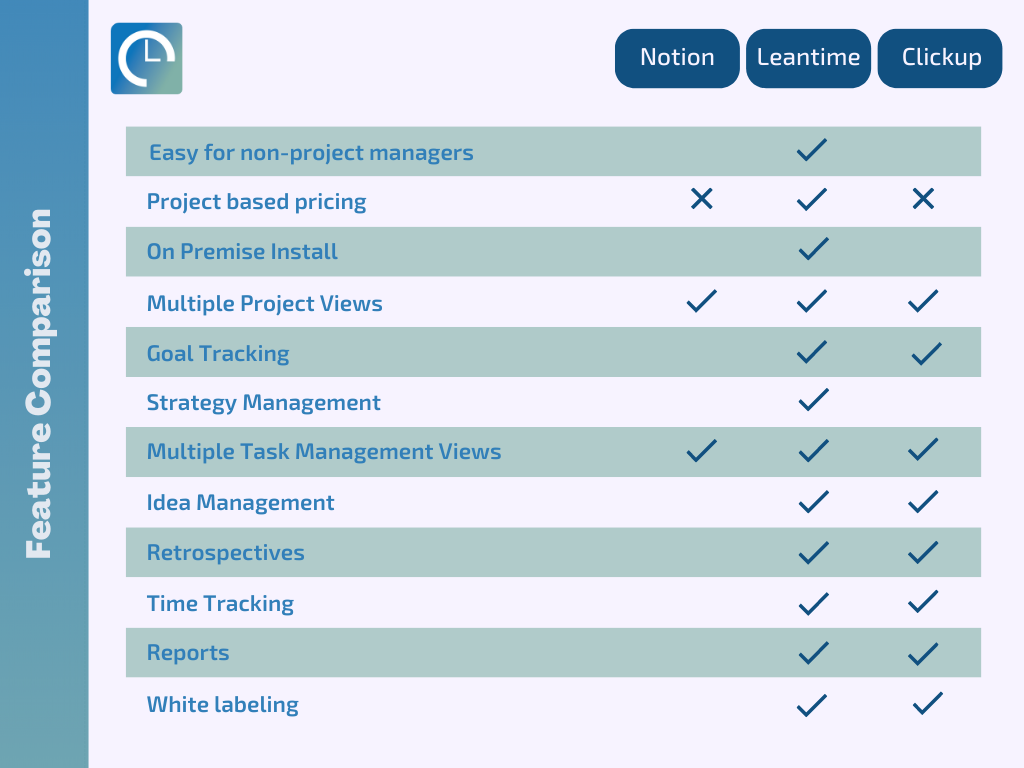
Feature Comparison chart – Leantime vs Notion vs Clickup
Leantime.io
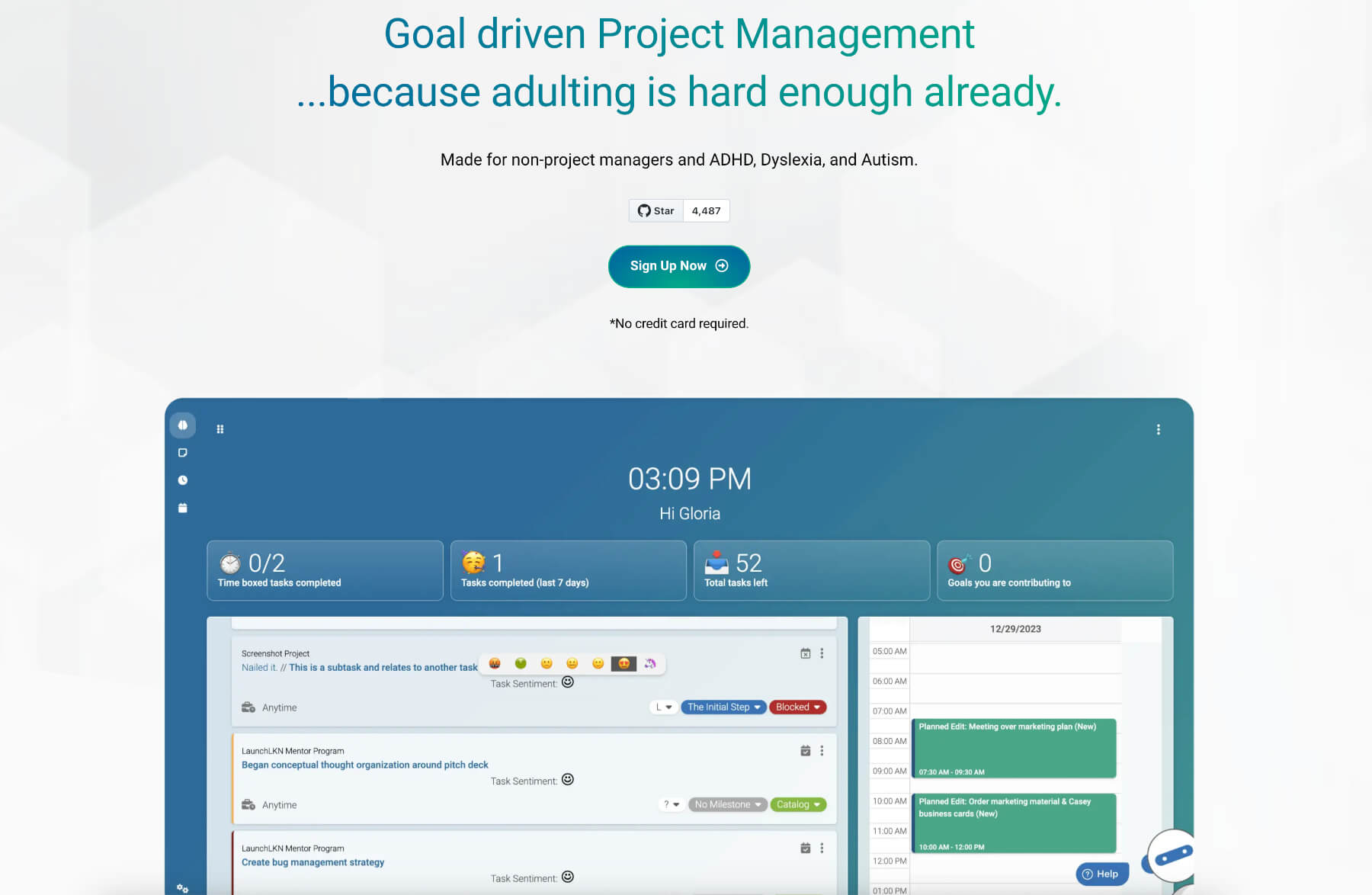
Pricing:
-
Self-Hosted (Free) / Free SaaS = Free
-
Essentials = $4/user/mo
-
Premium = $8/user/mo)
-
Ultimate = $10/mo/user)
-
Enterprise = Please contact us for pricing
G2 Rating: 4.7
Leantime, a project management tool, has achieved a G2 rating of 4.7, reflecting its high user satisfaction and functionality.
Year Released: 2019
It has never been easier for people to align their project plans with their project to-dos, manage their projects, get organized within their project activities and carry out the work in a hassle-free way with Leantime.
It is an open-source platform designed specifically for the strategy-minded entrepreneurial. The system is designed so that the user doesn’t have to have an MBA or PMP to get the best out of a project management tool and deliver systematic and repeatable project outcomes.
Driven by the blend of lean, agile, and design-thinking principles, the opinionated solution enables streamlining business & strategy development with project management throughout the full life cycle or a project: from ideation, validation, and planning to execution and final delivery.
Built from the ground up by tenured project managers, the platform now combines built-in features that help business-centric owners to scale successfully without any PM-related background.
By leveraging multiple innovation-powered Idea Boards, Research Boards, and To-Do task management tools, you can create alignment for the why across multiple projects for the entire team.
More than that, Leantime allows you to empower your milestone management with Gantt charts. It also allows you to manage research & project validation with Lean Canvas and time planning with timesheet management.
As Leantime’s best features are far from over, the platform provides Project Blueprint – an all-in-one dashboard for your team to leverage empathy boards, SWOT analysis, and goal management altogether. Built into every project and also part of their newer Strategy & Program management offerings.
Let your team and stakeholders get the project’s “why” with business-strategy alignment finally stockpiled in the same system.
Leantime also offers idea and advanced goal management — where the goals at the project and program levels can all report back up into the strategies you’ve developed. This gives you real-time access to KPIs.
Leantime project management platform provides comprehensive integration capabilities enabling your team to connect to Slack, Google Calendar, Dropbox, and Google Drive for improved data flow and collaboration.
Leantime Key Features
So, to recap the features of Leantime open-source project management software include:
-
-
Personal organization dashboard
-
Personal notes management
-
Time blocking with personal calendar
-
AI task prioritization-based science & on you feel about the work
-
AI subtask breakdown
-
AI-based personalized project descriptions
-
AI status update collection & AI generated status reports
-
Calendar Integration (Google Calendar, Ical URL)
-
Whiteboards
-
Program Management
-
White Labeling
-
Subtask Dependencies
-
Document Management (Wikis)
-
Strategy Management
-
Project Planning & Program Planning
-
Time Tracking
-
Retrospectives
-
Idea Management
-
Goal Management
-
SWOT, Empathy map, Lean Canvas+
-
Gantt Charts & Milestones
-
What end-users say about Leantime.io:
“The simplicity of the software was a nice relief. It’s simple yet very powerful and very customizable. I enjoy the functionality that comes with ease of use.”
- Capterra review
 ClickUp
ClickUp
Pricing:
-
Free
-
Unlimited = $9/member/mo)
-
Business = $12/member/mo)
-
Enterprise = Contact Sales
G2 Rating: 4.7
ClickUp, a versatile project management tool, has a 4.7 rating on G2, reflecting its high user satisfaction and advanced features.
Year Released: 2017
Trusted by Samsung, Stanley, and IBM, ClickUp is a market-leading workplace productivity platform released back in 2017 and secured over $537.5M in funding. Claimed to “replace them all”, the system offers customization capabilities, modifying fields, filters, views, dashboards, and other built-in objects without limits.
This project management solution helps businesses to streamline teamwork and collaboration with whiteboards, comments, proofing, emailing, and chat. Time management is no longer a hassle with tracking, estimation, and reporting functionalities.
More than that, workload and box views, ML-powered time tracking, goals, and insight-driven dashboards are among the core features that are now powering over 800,000 teams globally.
Regarding connectivity, the platform allows integration with multiple tools and third-party solutions like Slack, Google Drive, HubSpot, GitLab, DropBox, Google Calendar, YouTube, Zoom, etc.
ClickUp Key Features
Among the core features, Clickup provides the following project management functionalities:
-
-
Gantt Chart
-
Dashboards
-
Native Time Tracking
-
Mind Maps
-
Automation
-
Notepad
-
Integrations
-
Email
-
To-Do List
-
Kanban Board
-
Sprints
-
Many others
-
What end-users say about ClickUp:
“Clickup has become such an integral part of our work! By putting our work on ClickUp and organizing it into Sprints, we made it easy to work across departments without overloading ourselves with meetings and email threads.”
- Jakub, Inbound Marketing Team Lead
Notion
Pricing:
-
Free
-
Plus = $8/member/mo)
-
Business = $15/member/month)
-
Enterprise = (upon request)
G2 Rating: 4.7
Notion, known for its flexible and intuitive interface, has earned a 4.7 rating on G2, highlighting its effectiveness and popularity among users.
Year Released: 2016
Initially launched in 2016 as a note-taking solution, Notion became an all-in-one productivity platform bringing everyday work apps into one place. Backed with 30M users and $343.2M funding, the unicorn product now offers Wikis, Kanban Board, Database view, Project Pages, and other project management features.
In contrast to Leantime.io and Clickup, Notion has become a powerful yet feature-limited solution for startups, SMBs, and enterprise-level vendors, providing way fewer built-in capabilities. For example, out-of-the-box reporting, dependency visualization, and even marking critical milestones are unavailable for Notion users.
Instead, the original pioneering note-taking platform allows leveraging role assignment features, timelines, Gantt charts, budgeting, billing, and invoicing. Available views include table, list, calendar, kanban board, gallery, and timeline options.
More than that, Notion is a better choice for personal and small projects, offering a free tier for single users and furnishing them with a slick interface and basic project management capabilities.
Integration is another upper hand of Notion as it gives room by integrating with Slack, Zoom, Jira, Asana, GitLab, GitHub, and even Figma.
Notion Key Features
The platform is packed with the following in-built features and tools:
-
- Task management
-
- Calendar
-
- Collaboration tools
-
- Kanban boards
-
- Multiple prebuilt templates
-
- Custom databases
-
- Customizable databases
-
- Integrations.
What end-users say about Notion:
One of the biggest advantages of Notion is its design, which shows only the necessary information, avoiding overwhelming the members of the work team with unnecessary information, which favors us focusing on what really matters. Additionally, it stands out for the implementation of agile methodologies such as Kanban for the monitoring of activities.
- G2 review.
Project Management Tools Comparison
Now, let’s shed light on the key features and capabilities across Leantime vs Clickup vs Notion.
Now, let’s shed light on the key features and capabilities across Leantime vs Clickup vs Notion.
Planning to Conquer
Designed for business folks who have to manage projects but don’t think of themselves as a project manager, Leantime offers multiple in-depth opportunities to approach planning in a seamless and intuitive way. The platform allows breaking down projects into milestones and building visually appealing and data-driven Gantt charts.
Both views visualize attainable milestones by splitting the project into phases with accurate timelines. Thus, Leantime’s power enables your team to effectively assign tasks, manage tasks, communicate approximate delivery dates to every project-related party, and keep them all synced up without the millions of ever-irritating status emails.
Meanwhile, Clickup is packed with multiple task-based features that transform any project into a set of customizable tasks, informative subtasks, and many task-based properties to add.
The available views include list, board, and calendar as core options, while you can utilize advanced scenarios like map, activity, box, Gantt, mind map, table, timeline, and workload.
Although Notion wasn’t designed with project management solutions in mind, it still struggles even for market leaders. With table, board, timeline, calendar, list, and gallery views on board, the platform rolled out a unique feature – all views on the same page.
If you want to put it on a to-do list and complement it with a calendar view underneath, it’s not a shortcoming for Notion users.
Idea & Strategy Management
Leantime platform’s superpower is about providing idea and strategy management capabilities to entrepreneurial-minded do-ers wanting to stay on target by combining idea & strategy planning with their task management.
Users can break their know-how and light-bulb moments down on the Idea Board to store and manage them without distraction. Once ready to work and build on that idea, you can move on to research — shifting the ideas from an Idea Board over to a Research board with Simple and Advanced views.
With lean methodologies under the hood, Leantime’s Simple Canvas view is about the basic problem-solution-fit approach, while Advanced mode is designed to visualize the full life cycle of the product development process and help you move that business needle.
Read More: The Best Project Management Methodology
Leverage workflows from UVPs and budgets to costs and revenue streams in one place and get your ducks lined up in a row.
ClickUp, a popular project management software, is packed with over 15 customizable ways to visualize ideas, highlighting its Whiteboards and Mind Maps as the core options. Drawing mockups, putting down notes, uploading media, and developing multi-step connections within a single workflow are the built-in features Clickup has to offer.
In contrast to the adobe-mentioned project management-centric tools, Notion provides multiple brainstorming and ideation templates. They help generate, capture, connect, store, and sort ideas out-of-the-box by installing a specific template from the platform’s workspace.
Time Management with Timesheets
As the cornerstone of successful project management, time tracking is a must-have feature to assess your team’s engagement, measure the delivery process, and come up with accurate estimates. Leantime goes the extra mile with time management, offering an intuitive yet feature-rich Kanban view for time logging and a real-time built-in timer once you click the “Start Time” button.
ClickUp also has an upper hand in time and project management apps with notes, labels, billable time, sorting, filtering, rollup, and edit time features available within the timesheet functionality.
More than that, the project management software allows integration with multiple third-party time-tracking solutions like Time Doctor, Harvest, Everhour, Timely, Toggl, and others.
The platform also automates report generation, allowing you to leverage customizable reports and segment billable and non-billable entries.
Notion users will find time management a bitter pill to swallow as there are way fewer options and built-in functionalities. You can either adopt time-tracking templates or leverage third-party integrations to succeed. To offset the built-in limitations, Notion provides multiple integrations: Timely, Time Doctor, TMetric, Everhour, Jibble, etc.
Retrospectives
Retrospectives shouldn’t become an uphill battle for your team but a core activity to stay ahead of the competition. Here comes Leantime (an open-source project management software), enabling you to streamline retrospective communication, focusing on what worked well, what didn’t, and what the team should keep on doing.
To make retrospectives an easy go-to for business-driven users, the platform comes up with an intuitive Kanban view by default — thus helping to create multiple records and attach milestones to improve on right after the retrospective meeting.
ClickUp provides multiple sprint retrospective templates to download and leverage. Designed for Agile sprints and Scrum management, the platform enables teams to utilize whiteboards or meeting agendas as their retrospective aid to stay focused on continuous improvement.
Similar to ClickUp, Notion is fully packed with multiple free and paid retrospective project templates to transform future milestones into smooth sailing.
Pricing That Is Worth Investment
Leantime.io Pricing
Leantime has 3 basic pricing plans and a self-hosted option to place the open source project management software right on your desktop. When you self-host the system, it will require some coding/development skills and has the following requirements:
-
- PHP 8.0 and up
-
- Apache with mod_rewrite, Nginx, IIS (possible with adjustments)
-
- MySQL 5.7+
-
- PHP Extensions needed
-
- Curl (for Integrations), gd, imagick, xml (for 2FA QR code generation), ldap (optional).
The self-hosted tier is about installing the platform yourself with on-your-own hosting and includes unlimited users and clients, highly customizable source code, tailored domain, and white labeling.
While most SaaS-centric productivity platforms follow user-based pricing, Leantime was designed to empower entrepreneurial-minded teams to focus on projects instead of users. Backed with a project-based mindset, the platform offers unlimited users per project – an upper hand for your startup team to join and scale without roadblocks.
Want to proceed with a hosted tier? Here come the One Project Wounder ($0/project/month), Business ($12.49/project/month), and Enterprise (custom quote) licenses. The latter plan includes on-premise installation within your specific infrastructure, LDAP/SSO Integration, Telemetry & Auditing, custom onboarding & migration, and premium support with SLAs.
Used to leverage the self-hosted option, but now need to migrate to the cloud? No sweat. Leantime’s technical team will facilitate smooth cloud migration for a small fee.
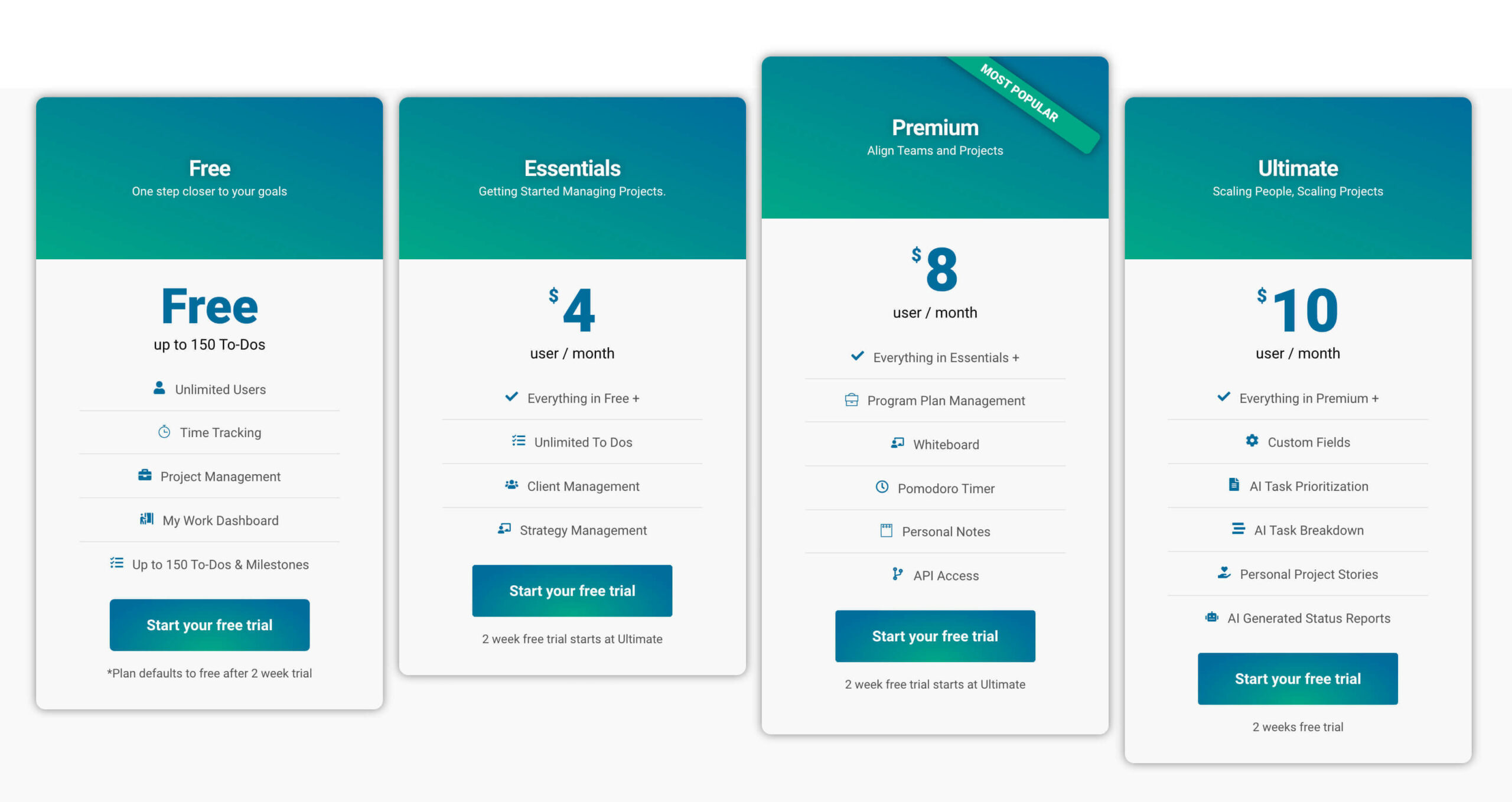
ClickUp Pricing
ClickUp is a SaaS-based project management platform that provides a free forever license for small teams requiring no more than 100MB storage to kick off project management initiatives. The paid plans include Unlimited ($7/member/mo), Business ($12/member/mo)), and Enterprise (custom quote) options.
Notion Pricing
The lion’s share of Notion users are using a free tier with the number of guests limited to 5. Next, the paid front comes into play with Personal Pro ($10/member/mo), Team ($15/member/mo), and Enterprise (custom quote) plans (if billed monthly).
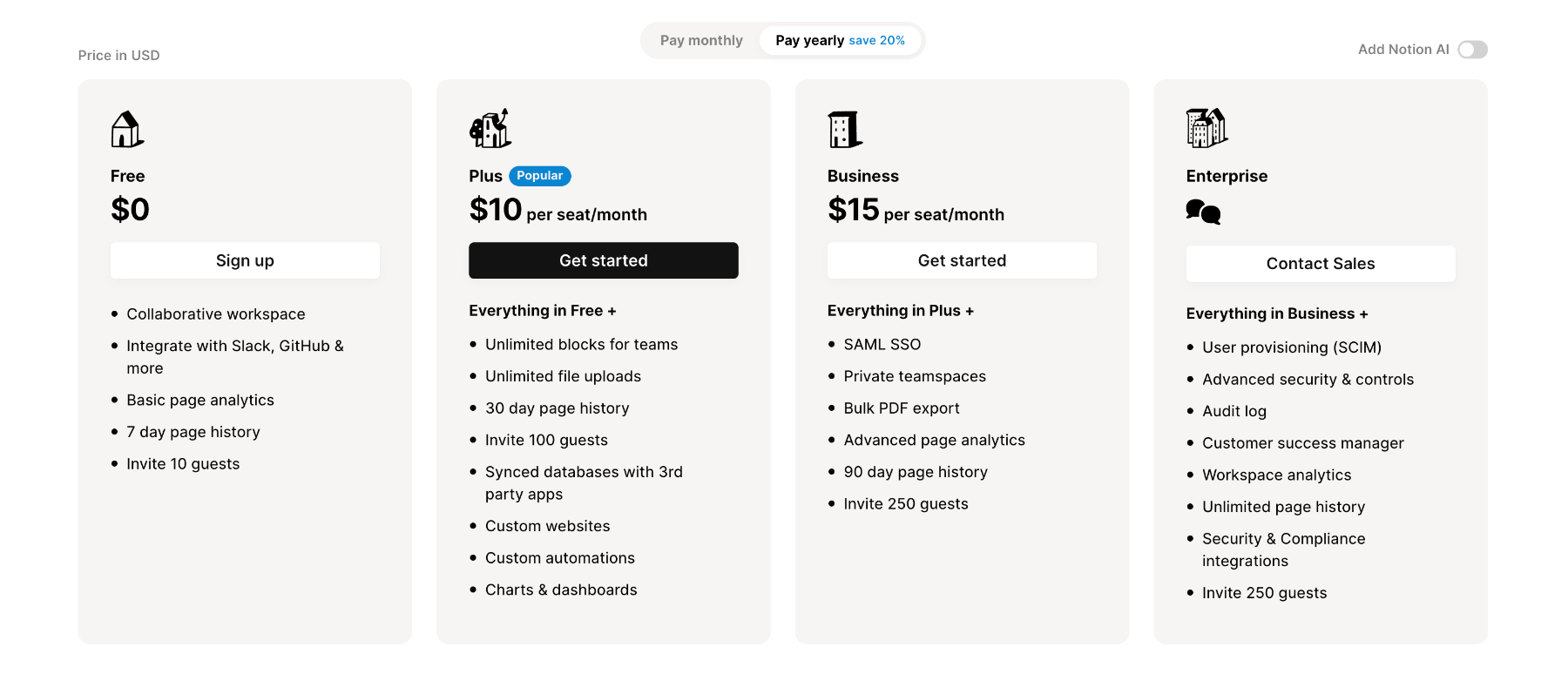
How Leantime Project Management Software is Different
Released by decade-experienced project managers and built for entrepreneurial-minded business owners and teams, Leantime is trusted by thousands of users globally with 6k+ installations, 10,000+ active projects, and 84,000+ to-dos created. The platform’s open-source nature drives the ever-evolving community growth with powerful contributors empowering the product.
Now we want to cover the most innovative and stand-out features of Leantime that will help business-driven teams boost productivity, eliminate delivery roadblocks, and achieve milestones in a cost-compressed and easy manner.
Managing Ideas In One Place
The platform revolutionized the way existing project management tools enable users to approach idea management. As an idea stands behind any successful project, Leantime’s team decided to roll out a built-in feature to break down all your light-bulb moments and insights in one place.
Idea Boards allow leveraging both the problem-solution-fit approach and full-cycle project management process. But here comes the next level feature of enabling business-driven execs to scale:
You no longer need to utilize to-dos, external tools, or pen and paper to store and manage your ideas or notes. Keep them all in one place and transfer them to the Research Board once you get started.
More than that, you can plug in your ideas to a new or existing milestone if they relate to an ongoing project or may cause changes simply by adding a required milestone to a specific idea.
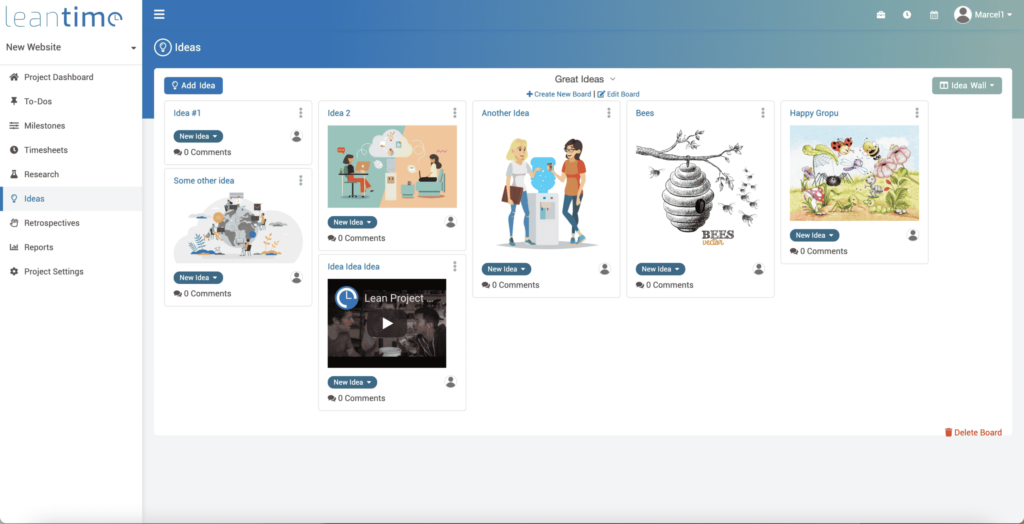
Planning Made Easy: Combine Strategy & Task Management
It has never been easier to manage and plan your project activities — whether you have project management experience or not. The platform hits the mark for non-project managers in making the planning process as intuitive and transparent as ever before. The road mapping functionality lets you break down complex projects into milestones or visualize the goals via the goals board.
Both options help keep an overview of the why and when of the project phase, with the Gantt chart view allowing for a time overview. As a result, you can keep all project-based parties involved and synced up automatically.

Time Management That Saves Your Time
Time tracking is an essential element of any productivity platform and should be designed in a user-friendly. While most Jira-like tools require some time to deal with time tracking, Leantime’s product follows the ‘track-n-go’ approach with intuitive workflows to speed up your time tracking.
You can go further and leverage a Kanban board with a real-time start/stop timer to track project’s progress accurately and measure time to completion to provide way more accurate estimates in the future.
SWOT, Empathy Map, Lean Canvas+
Moving into next-level features, Leantime project management provides 2 options for project definition: Goals and SWOT. Build up brand-new goals, set up current and target values, monitor the progress bar, modify statuses, spot strengths, weaknesses, opportunities, and opportunities in the same system, and keep the project manager and the entire team informed.
On the project validation front, the platform offers empathy maps and Lean canvas strategies to validate the project status and ensure the entire team works on high-priority and right tasks.
Google Docs are now Out Of The Box
Leantime open source project management software helps avoid utilizing Google Docs and other external document managers outside the platform. You no longer need to distract your focus and switch between tabs to prepare comprehensive Wiki, release notes, or project-related blogs.
You can edit the files in either location by embedding your Google Docs directly into your Leantime documents.
Conclusion
The Leantime vs. Notion vs. ClickUp are all popular project management tools and this comparison guide helped show that each productivity tool provides multiple powerful yet different opportunities to meet your project management goals.
While Leantime is a brand-new platform that makes project management intuitive and scalable again by combining strategy and task management, ClickUp and Notion require taking some time to learn the tool before you can take to the functionality like a duck to water.
Looking for open-source project management software to start managing your project now without limitations? Try Leantime for 1 project for free or self-host the platform at no cost.
Frequently Asked Questions
ClickUp is better than Notion in the project management app landscape, providing multiple out-of-the-box features while Notion is an all-in-one productivity platform with tons of templates that address project management needs.
On the productivity boost front, ClickUp and Notion share multiple common features and opportunities. However, ClickUp is a more project management-focused platform, while Notion is a template-based solution allowing you to put many assets in one place.
Leantime is good for startups,entrepreneurial-minded individuals, and big or small teams wanting to make managing projects easier and more successful with successful project outcomes.









